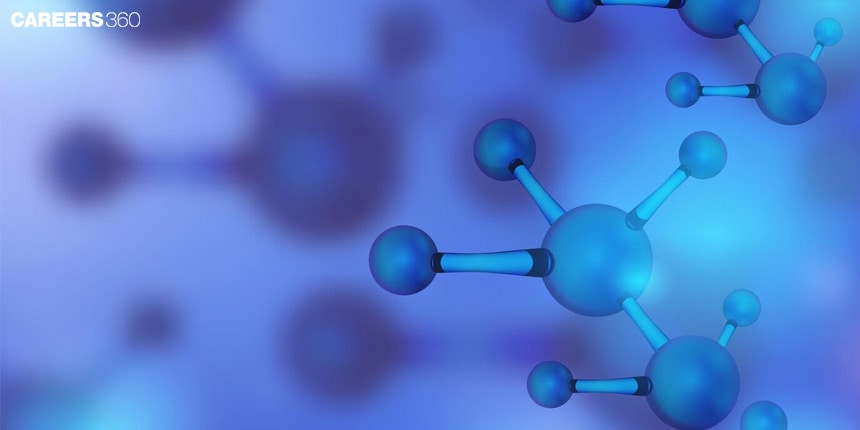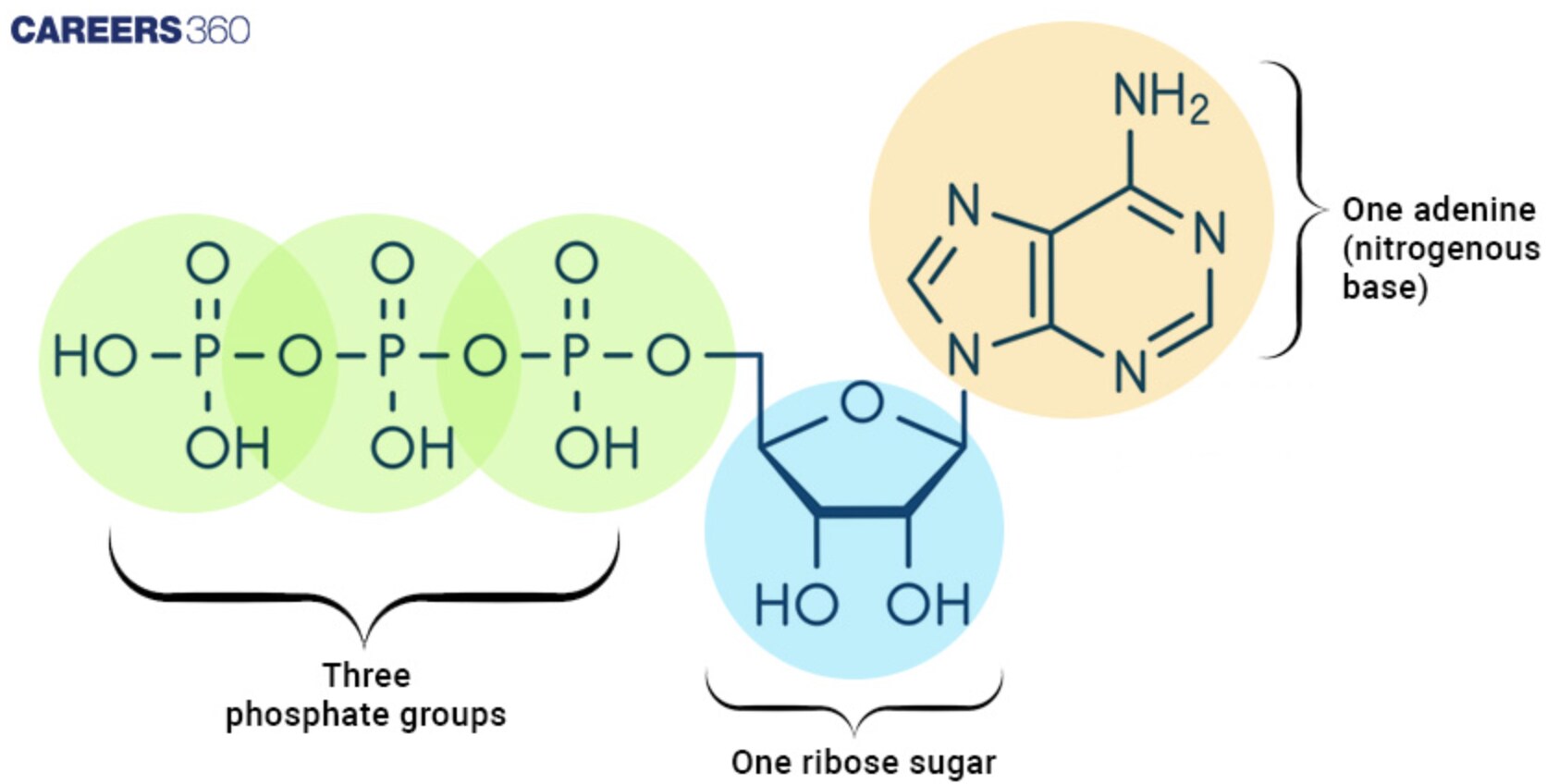ATP - Energy Currency of the Cell, Structure, Functions, FAQ
What is ATP?
Full form: ATP is a nucleotide and is made up of an adenine base, a ribose sugar and three phosphate groups. This is the reason why it is known as the energy currency of the cell because it plays a central role in energy fulfilment.
Discovery and historical background: ATP was for the first time extracted and characterized as an essential component of cell metabolism by German Chemist Karl Lohmann in the year 1929. Later, Fritz Albert Lipmann in the 1940s determined its role in biology which earned Lipmann the Nobel Prize for the work done on ATP in 1953.
NEET 2025: Mock Test Series | Syllabus | High Scoring Topics | PYQs
NEET Important PYQ's Subject wise: Physics | Chemistry | Biology
New: Meet Careers360 B.Tech/NEET Experts in your City | Book your Seat now
- What is ATP?
- Structure of ATP
- How ATP Works: The Energy Cycle
- Production of ATP
- Role of ATP in Cellular Functions
- Regulation of ATP Production and Utilization
- Recommended video for ATP - Energy Currency of the Cell

Role of ATP in energy transfer within cells: Thus ATP serves as an energy shuttle that imports and exports energy within the cells. In cellular respiration energy from the nutrients is harnessed and used to produce ATP from ADP (adenosine diphosphate). This highenergy phosphate bond in ATP can then be hydrolyzed to ADP and phosphate, energy is released for cellular activities such as muscle contraction, transport of molecules across cell membranes, and synthesis of proteins and lipids among others.
Structure of ATP
The ATP structure is discussed below:
Molecular structure:
ATP or adenosine triphosphate consists of adenine which is a base, ribose which is a type of sugar and three phosphate radicals. Adenine is one of the nitrogenous organic bases; ribose is a fivecarbon sugar or pentose. All three phosphate groups are bound to the backbone of the ATP molecule and they follow each other in the ribose sugar of ATP.
Explanation of highenergy phosphate bonds:
Concerning the high energy phosphate bonds in ATP, the term phosphate relates to phos which is between phosphate groups, or of the terminal phosphate group. These bonds are described as highenergy bonds primarily due to their inherent nature, and their capability of releasing massive energy once broken. This is more an explanation of instability because of the negative phosphate groups as well as the resonance in ATP molecules.
Diagram of ATP molecule

How ATP Works: The Energy Cycle
The working of ATP is discussed below:
ATP hydrolysis:
ATP hydrolysis looks at the conversion of ATP to ADP (Adenosine Diphosphate and Pi – Inorganic phosphate). This process liberates energy which the cells need to fuel several biochemical reactions and several cellular activities. ATP is hydrolyzed by enzymes called ATPases that help in the transfer of the phosphate group to other molecules usually a substrate in metabolic pathways.
ATP synthesis:
ATP synthesis is a process that operates in contrast to ATP hydrolysis where Adenosine diphosphate (ADP) with the inorganic phosphate (Pi) make ATP. This synthesis is mainly done in cellular respiration whereby in the mitochondria energy from nutrients is used in the synthesis of the phosphate group back to ADP. The enzyme that catalyses this reaction is ATP synthase which proceeds through the use of the proton motive force across the inner mitochondrial membrane to synthesise ATP.
Diagram of the ATP-ADP cycle

Production of ATP
The ATP production is discussed below:
Cellular respiration overview: Another important process that occurs in a cell is called cellular respiration it is a process by which the cell gets energy from glucose molecules to produce ATP.
Glycolysis:
In the cytoplasm, glycolysis works and splits the glucose into pyruvate; it produces a small amount of ATP and NADH.
Krebs cycle (Citric Acid Cycle):
Occurring in the mitochondria, the Krebs cycle oxidises the acetyl CoA formed from pyruvate into ATP, NADH, and FADH2.
Electron Transport Chain:
Located in the inner mitochondrial membrane, the ETC takes electrons from NADH and FADH2, and transfers them to oxygen to produce a huge amount of ATP by oxidative phosphorylation.
Photosynthesis in plants: Photosynthesis is the provider of chemical energy in the form of glucose and this is the process through which plants, algae and certain bacteria convert light energy into chemical energy in the form of glucose through the production of ATP.
Light-dependent Reactions:
Happening in the thylakoid membranes of chloroplasts, photophosphorylation processes involve light energy to bring about cleavage of water molecules to give ATP and NADPH.
Calvin Cycle:
Occurring in the stroma of chloroplasts, this cycle known as the Calvin cycle, makes use of ATP and NADPH products of the lightdependent processes to reduce carbon dioxide into glucose through several enzymecatalyzed steps.
Comparison of ATP yield from different processes (table/chart)
Process/Pathway | ATP Yield per Glucose Molecule | Location | Key Steps and Description |
Glycolysis | 2 ATP | Cytoplasm | Breaks down glucose into pyruvate |
Krebs Cycle (Citric Acid Cycle) | 2 ATP | Mitochondrial matrix | Oxidizes acetyl CoA to produce NADH, FADH2, and ATP |
Electron Transport Chain | 2832 ATP | Inner mitochondrial membrane | Uses electron carriers (NADH, FADH2) to generate ATP via oxidative phosphorylation |
Total ATP from Cellular Respiration | 3236 ATP | Mitochondria | ATP produced from the complete oxidation of glucose |
Photosynthesis | 18 ATP (per 6 NADPH and 9 ATP) | Chloroplasts | ATP produced during lightdependent reactions and the Calvin cycle |
Role of ATP in Cellular Functions
The functions of ATP are discussed below:
Muscle contraction
It has been mentioned that ATP is significant for muscle contraction because it is required to produce tension between actin and myosin filaments of the muscle fibre to enable contraction and, hence, bring about movement.
Active Transport Across Cell Membranes
ATP provides direct energy for transporting substances across the biological membranes by functioning as the direct energy source for membrane proteins such as pumps and carriers that transport ions and molecules from one area to another against a gradient, which could be concentration, electrical or both.
Biosynthesis of Macromolecules
ATP provides the energy needed for the building of other large molecules like proteins, lipids and nucleic acids for the growth, repair and replication of cells.
Signal Transduction Pathways
ATP is directly involved in signal transduction by adding phosphate groups to proteins that alter the activity of enzymes and the genes involved in cell signalling and adaptation to environmental stimuli.
Heat Production (Thermogenesis)
ATP hydrolysis both gets and loses energy. The energy is used to power cellular workings, and control heat and metabolic reactions.
Regulation of ATP Production and Utilization
The regulation of ATP is discussed below:
Enzymes involved in ATP synthesis and breakdown
ATP Synthesis: ATP synthase is a beautiful enzyme which facilitates the process of ATP synthesis through oxidative phosphorylation in mitochondrion and photophosphorylation in chloroplast.
ATP Breakdown: ATPases; ATP synthase; reverse the process by breaking ATP into ADP and phosphate for another cellular process to demand energy.
Role of ATP in metabolic regulation
Energy Currency: ATP is the energy-transporting process that fuels metabolic processes in a cell such as glycolysis, the citric acid cycle, and oxidative phosphorylation.
Activation Energy: Atp reduces the energy that is needed to start up metabolic reactions hence making the metabolic process faster.
Feedback mechanisms
Negative Feedback: ATP also diminishes the ways that produce ATP such as glycolysis and the citric acid cycle, thus conserving energy.
Positive Feedback: ATP depletion activates feedback that can reenergize the cell through other energy-producing pathways.
Recommended video for ATP - Energy Currency of the Cell
Frequently Asked Questions (FAQs)
ATP or adenosine triphosphate is a molecule which is responsible for storing and transporting energy within cells. It is known as the energy currency of the cell because it supplies energy in such cell functions as muscle contraction, protein synthesis, active transport, etc as it liberates energy when its phosphate linkage is split.
ATP is generated mainly by cellular respiration and photosynthesis processes that occur in living organisms. ATP is synthesized in glycolysis uniquely in cytoplasm while during the citric acid cycle and oxidative phosphorylation in mitochondria. In photosynthesis, during the light-dependent reactions, ATP is synthesized inside chloroplasts.
The roles of ATP in the human body include contracting muscle, maintaining a charge for nerve impulse transmission, transport of molecules across cell membranes, as well biosynthesis reactions including protein synthesis.
ATP points to where the energy is stored that is in between the phosphate groups of phosphates. In ATPase enzymes, the phosphate bond gets broken, and the energy started is released to do cellular work. This process lets ATP become ADP (adenosine diphosphate) and inorganic phosphate in the body.
Here ATP is generated by the oxidation of glucose and other organic compounds in the presence of oxygen which is called aerobic respiration. This occurs in mitochondria and involves glycolysis, citric acid cycle and oxidative phosphorylation. In photosynthesis, ATP is produced during the light reactions which occur in the chloroplast where light energy is used to convert Water to ATP and NADPH. The process does not require the element oxygen and is called photophosphorylation.
Also Read
27 Dec'24 05:51 PM
23 Nov'24 05:46 PM
08 Nov'24 05:04 PM
08 Nov'24 10:59 AM
08 Nov'24 09:54 AM
08 Nov'24 09:26 AM
08 Nov'24 09:01 AM
07 Nov'24 10:17 PM
07 Nov'24 09:50 PM
07 Nov'24 04:38 PM